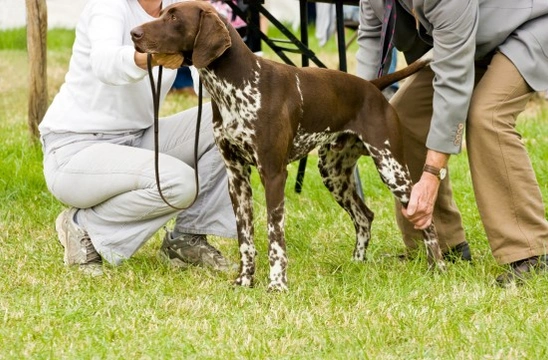
Teaching your dog show craft
If you own a pedigree dog and you think they stand a good chance of holding their own against other dogs of their breed in the show ring, you might consider entering your dog in a breed show and finding out what they can do! If your dog is registered with The Kennel Club and is eligible to enter shows, you might think that you are ready to send your entries off, and take your dog along to give it a whirl. This is a great idea, and you should certainly view your first few shows as a learning experience for both dog and owner, and not necessarily expect to get placed or walk off with the trophy!
However, even for your very first dog show, it is important to teach your dog about how to behave in the ring, and how to stand, run and present themselves to the judges in the way that will be expected of them without showing yourselves up!
Read on to learn about how to teach your dog show craft, and what is expected within the ring.
Standing or “stacking”
“Stacking” is the term used to refer to the way that the dog stands still for examination, and the exact position that this should take will vary according the requirements of different dog breeds. Stacking is intended to show the conformation and build of your dog clearly, and highlight their best features.
Within the show ring, some dog breeds are expected to be “hand stacked,” which means that the handler will manually position the dog’s legs into the position that they should be in, and stand or kneel nearby while they are being viewed.
Other breeds should be “free stacked,” which means that the handler will stand a couple of steps away from the dog drawing their attention, while the dog stands in their natural position and profile.
Teaching your dog about either method and training them to remain in position for a couple of minutes so that they can be viewed in their best light is something that you should take some time over, as if your dog will not “stack” in the ring, they will not be judged very highly!
Your dog’s front legs should be positioned under the shoulder blades, and straight, with the feet facing forwards squarely. Be firm and consistent in your training, but never scold your dog or get frustrated with them, and reward them with praise when they stack correctly.
Gaiting
Gaiting is the term used to refer to running your dog out in front of the judges, so that they can see the way your dog moves. The “gait” in question is usually a trot rather than a walk or an outright run, and this pace is often not one that comes naturally to all dogs. There are a few breed-specific exceptions to the trotting rule, the main one being the Old English Sheepdog, which should pace rather than trot.
Your dog should be trotted out to heel and able to keep pace with you and look to you for direction in when to chance pace, and should always be placed on the side of the judges, so that the judges see your dog and not your own legs!
The front and rear diagonal opposite legs should move in tandem, and it may take some practice for dog and owner to establish the correct and comfortable trotting pace for the dog, which can vary from breed to breed. Practice trotting your dog by teaching them a command that you are about to lead off, then running them in a straight line for around forty feet before turning and going back to your starting point. In some show rings, you will pace your dog in a circuit around the ring as well, but the most common method of judging is to pace your dog away from the judges and then back past them.
Once you come to the end of your trot, is it important to finish off neatly rather than let the pace peter out; teach your dog to end their trot out by free stacking for a few seconds before relaxing.
Physically judging your dog
Part of the judging process will usually involve the judge or judges handling and touching your dog, and it is a great idea to get your dog used to being touched and handled by a wide variety of people. Your dog should be friendly and amenable to the judge’s approach, but not take it as a cue to roll around or invite belly rubs! While this might endear your dog to the judges somewhat, it is unlikely to cause them to rank well! Smaller dogs should also get used to being picked up without incident.
Expression
Even when your dog is not being stacked or looked at directly, they should display an open, alert expression and appear interested in what is going on and as if they are having a good time. Of course, the best way to achieve this is to ensure that your dog actually is interested in what is going on around them and that they are having a good time!
Make sure that both showing and practicing for showing is fun for your dog, and develop some tips and tricks to keep them engaged, alert and looking at you, such as keeping treats close to hand to keep your dog guessing, and talking to them to keep their heads up and eyes on you.



